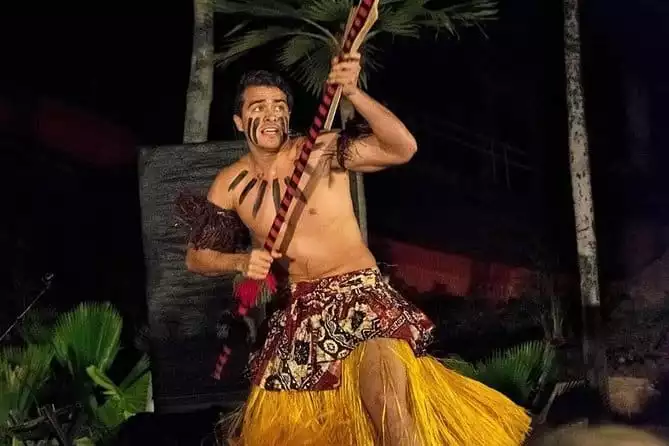In this Article
Toggle



What is a luau? Picture a Hawaiian sunset, the aroma of rich, smoky kalua pig wafting through the air, and the gentle sway of hula dancers against a backdrop of rolling waves. This is a Hawaiian luau, a celebration steeped in history and bursting with culture.
When you think of Hawaii, a few images might spring to mind: pristine beaches, lush landscapes, and, of course, the iconic luau. But beyond the tourist brochures and Hollywood portrayals lies a rich tapestry of tradition and celebration. This article answers the question, “What is a luau?” by delving into its history, customs, and the delicious foods that await you at one of these festive Hawaiian gatherings. Whether you’re visiting the island for a relaxing vacation, a romantic destination wedding, or to enjoy a babymoon in Hawaii, this guide tells you everything you need to know before attending a luau.

To help offset the costs of running EverydayWanderer.com, you’ll find affiliate links lightly sprinkled throughout the site. If you choose to make a purchase via one of these links, there’s no additional cost to you, but I’ll earn a teeny tiny commission. You can read all of the legal blah blah blah (as my little niece says) on the full disclosure page.
What is a Luau?
A luau is more than just an oceanside party — it’s a Hawaiian feast marked by a unique combination of food, music, and dance. Historically, it’s a way for Hawaiians to celebrate major life events in the company of friends and family. Today, luaus have become a symbol of Hawaiian hospitality, showcasing the vibrant culture and traditions of the islands.
The History of the Luau
The roots of the luau date back to ancient Hawaii. It was a time when the ‘aha’aina (feast) was a communal event, but with strict rules about who could eat what and with whom. The transformation into what we now know as a luau began in 1819, when King Kamehameha II abolished traditional eating customs, allowing men and women to dine together. This pivotal moment marked the beginning of the modern luau, a celebration of unity and equality.

What to Wear to a Luau
Are you attending a luau when you visit Hawaii? When it comes to the luau dress code, think comfortable, tropical, and colorful. Men often wear aloha shirts paired with khakis or linen pants, while women opt for floral dresses or skirts. Kids should don Hawaiian outfits that are cool and comfortable. Luaus are family-friendly, so dress your kids in something they can play and move around in.

When it comes to footwear, continue to think casual and comfortable. Simple sandals or basic flip-flops — called “slippers” in Hawaii — are ideal for both men and women. If you plan to choose traditional mat seating at the luau, removing your shoes is customary as a sign of respect, so it’s best to wear shoes that are easy to slip off and on.

Luau Etiquette
While luaus are relaxed and festive, there are a few customs that are worth noting. For instance, it’s customary to wear the lei you’re given upon arrival as a sign of respect. Also, while it’s a buffet-style feast, be mindful of food wastage. Take what you’ll enjoy, but remember, it’s about sharing and appreciation.

Traditional Food at a Hawaiian Luau
The Hawaiian food served at a luau is typically served buffet style. Look for these items at a luau buffet:
- kalua pig, wrapped in banana leaves and cooked in an underground oven called an imu
- poi, mashed taro root
- macaroni salad, a creamy side dish made with elbow macaroni
- lomi-lomi salmon, a traditional side that combines salted salmon with tomatoes, onions, and scallions
- sweet potatoes
- haupia, a coconut pudding that resembles jello
- kulolo, a type of pudding loaf made with grated taro, sugar, and coconut milk
- tropical fruit like mango, pineapple, and papaya
These delicious dishes are a tasty reflection of Hawaii’s diverse agricultural and cultural history.

Seating at a Luau
Seating at a luau can vary from communal seating at tables and chairs that encourage mingling and interaction among guests to traditional seating on mats on the ground. While mat seating provides a more authentic experience, consider your comfort, as you’ll be sitting for an extended period. If you opt for mat seating, removing your shoes is customary as a sign of respect.

Entertainment at a Traditional Luau
The entertainment at a luau is a vibrant showcase of Hawaiian and Polynesian culture. Expect to see hula dancing, which tells stories through movement, and hear lively music typically featuring a ukulele. Fire knife dancing is another highlight, offering a thrilling display of skill and bravery.

Embracing the Spirit of Aloha
As our journey through the enchanting world of luaus concludes, it’s clear that these gatherings are a heartfelt expression of Hawaiian culture and hospitality. More than just a feast, a luau is an immersive experience that connects us to the rich tapestry of Hawaii’s history and traditions. So, the next time you find yourself in the islands, embrace the opportunity to experience a luau and immerse yourself in the true spirit of aloha.
|
||
|
||
Have You Attended a Hawaiian Luau?
Have you experienced the magic of a Hawaiian luau? What was your favorite part – the tantalizing food, the mesmerizing dances, or perhaps the warm, welcoming atmosphere? Whether it’s a funny story, a special moment, or a piece of advice for fellow travelers, share your experiences in the comments below.

Looking for more information to plan your Hawaii vacation? Check out my additional recommendations to help you plan your trip to Hawaii including what to see and do in Hawaii, the best places to stay in Hawaii, where to eat in Hawaii, and more!
Ready to Go?
Use These Helpful Links to Book Your Trip!
- Find low fares with airfarewatchdog and Skyscanner
- Book your plane ticket with Expedia or Kayak
- Or take the scenic route on an epic road trip in a rental car or an RV from Outdoorsy
- From hotels to private homes, find the perfect accommodation with Hotels.com or Vrbo
- Travel in style with a suitcase, carry-on, backpack, or handbag from eBags
- Save on tickets to attractions, sightseeing tours, and more with CityPASS, Tiqets, and Viator
- Don’t leave home without travel insurance from AXA
- Discover the sights, history, and culture of your destination with an interactive scavenger hunt
- Need something else to plan your perfect trip? Visit my travel resources page for more trusted partners. Happy wandering!
Thank you for sharing!













This makes me appreciate the tradition even more. Thank you for sharing this post.